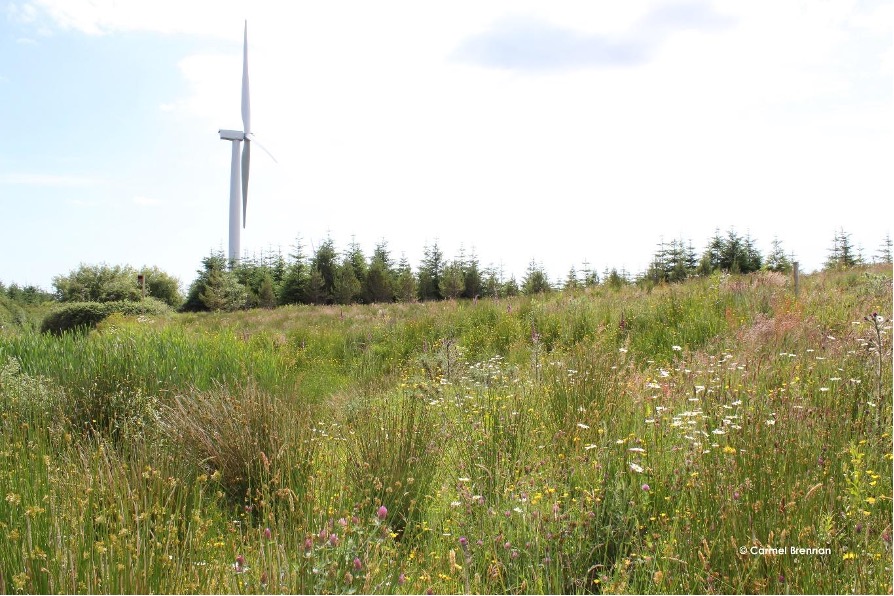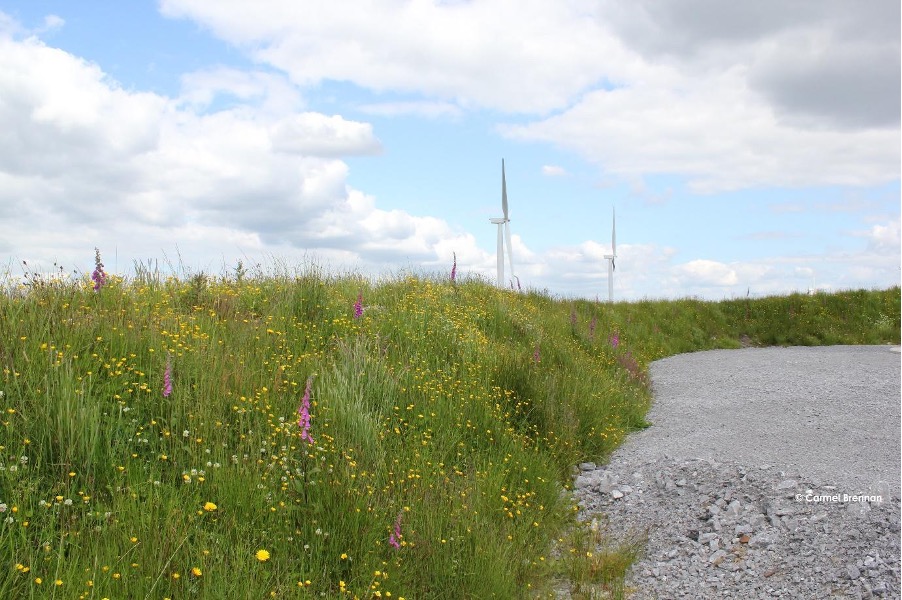
Nature+Energy: What If Onshore Wind Farms Were Also Nature Reserves?
Author – Aoibheann Gaughran
There is clear scientific consensus that we need to transform our energy systems to reduce Green House Gas emissions and play our part in limiting global warming to 1.5°C. Ireland’s climate action plan includes an increase in renewables to 70% of our energy needs by 2030. While solving our energy challenges, we are also faced with a biodiversity emergency.
What is biodiversity and why should we care?

Biodiversity encompasses all life on earth – plants, animals, fungi, bacteria, and other microorganisms, as well as the ecosystems in which they live. Biodiversity (or nature) is not just beautiful; it is our life-support system. We eat plants and animals. Insects, and even some mammals and birds, pollinate many of the foods we rely on. Soil microbes provide nutrients that plants need to grow. Vegetation and healthy soils reduce flooding and filter our water. Plants provide us with clean air. Detritivores and scavengers break down waste (imagine a world without dung beetles!). Peat bog and woodlands draw down and store atmospheric CO2. These natural goods and services are known as “ecosystem services”. We utterly depend on these services, but nature needs to be in good condition to supply them.
Human population growth, industrial and agricultural intensification[1],[2], and accelerating land-use change[3], mean that around 1 million animal and plant species are threatened with extinction globally, many within decades[4].
In Ireland, 85% of our protected habitats are in inadequate or poor condition[5], one-fifth of our breeding bird species are in decline[6], and 43% of our rivers are in unsatisfactory biological quality[7]. Climate change puts further pressure on our already creaking biodiversity. Nature does not have the capacity to absorb more negative impacts. As our biodiversity declines, so does its capacity to supply essential ecosystem services.
Wind farms, although crucial to achieving our green energy targets, can have negative impacts on biodiversity – through habitat fragmentation/destruction, displacement of flora and fauna, and mortality of species at risk of turbine collision. Good planning, appropriate siting, ongoing monitoring and site management can mitigate many of these impacts. Current legal requirements and the planning process require us to pay specific attention to specially protected habitats and species, such as the hen harrier, and the focus is on mitigation of negative effects. But what if wind farms could actually enhance biodiversity?
Nature+Energy
There are over 300 onshore wind farms in the Republic of Ireland. These wind farms have the potential to provide so much more than renewable energy. If managed properly for biodiversity, our network of wind farms could act like mini-nature reserves, creating space for nature, connecting habitats, improving the resilience of ecosystems to climate change, and enhancing the provision of ecosystem services. The Nature+Energy project will develop methods for recognising and enhancing the biodiversity that exists on our wind farms.
Natural Capital Accounts (NCAs) will be developed for focal sites. Natural Capital Accounting frames natural ecosystems as stocks of assets that provide a flow of benefits to people. It is a tool that enables the integration of nature into business decision-making, to reduce and reverse trends in environmental degradation and biodiversity loss. Accounts will be developed using existing data, as well as data from site surveys. The extent and condition of habitats within wind farms will be quantified, as will the services and benefits that they provide. The NCAs will support a natural capital asset and risk register, and a decision-support tool for land-use planning and biodiversity enhancement on wind farms.

A state-of-the-art environmental monitoring system (EMS) will be developed to revolutionise how we measure and monitor biodiversity on and around wind farms. High-resolution monitoring could identify the presence of at-risk species, or risky times of the day or season where temporary curtailment of turbine operation could protect at-risk species without compromising energy production.
Companies are increasingly incorporating biodiversity into their strategies. Many WEI members have already signed up to the All Ireland Pollinator Plan, which recently launched sector-specific guidelines[8]. However, a lack of site-specific scientific knowledge can often frustrate well-intentioned plans. The data generated by Nature+Energy will be used to develop evidence-based Biodiversity Action Plans and outline priority actions for investment in biodiversity across the sector, actions that go beyond what is required in planning conditions, to provide benefits to local communities, nationally, and even internationally.
Climate change and the erosion of biodiversity are the twin environmental crises facing humanity. Nature+Energy aims to develop genuine win-win scenarios for climate and biodiversity action that will benefit society, the economy and the environment.
Nature+Energy is a four-year project co-funded by Wind Energy Ireland, The NTR Foundation, ESB, SSE Renewables, Energia Renewables, Ørsted, EnergyPro, Ecopower, Greencoat Renewables Plc, and MaREI, the Science Foundation Ireland Research Centre for Energy, Climate and Marine, and is led by teams at Trinity College Dublin and Maynooth University.


